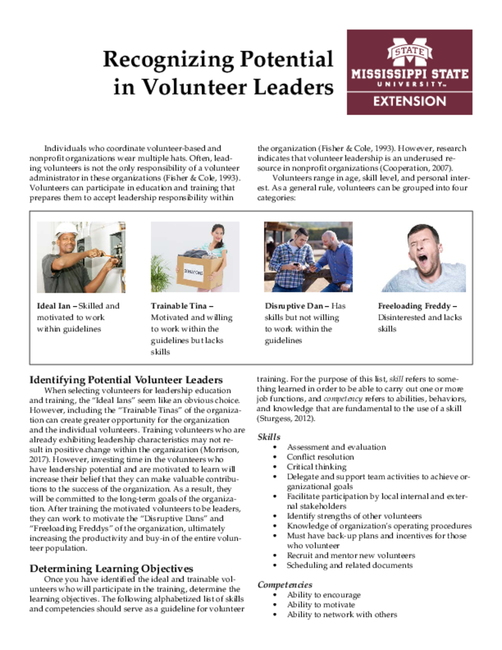Recognizing Potential in Volunteer Leaders
Individuals who coordinate volunteer-based and nonprofit organizations wear multiple hats. Often, leading volunteers is not the only responsibility of a volunteer administrator in these organizations (Fisher & Cole, 1993). Volunteers can participate in education and training that prepares them to accept leadership responsibility within the organization (Fisher & Cole, 1993). However, research indicates that volunteer leadership is an underused resource in nonprofit organizations (Cooperation, 2007).
Volunteers range in age, skill level, and personal interest. As a general rule, volunteers can be grouped into four categories:
Identifying Potential Volunteer Leaders
When selecting volunteers for leadership education and training, the “Ideal Ians” seem like an obvious choice. However, including the “Trainable Tinas” of the organization can create greater opportunity for the organization and the individual volunteers. Training volunteers who are already exhibiting leadership characteristics may not result in positive change within the organization (Morrison, 2017). However, investing time in the volunteers who have leadership potential and are motivated to learn will increase their belief that they can make valuable contributions to the success of the organization. As a result, they will be committed to the long-term goals of the organization. After training the motivated volunteers to be leaders, they can work to motivate the “Disruptive Dans” and “Freeloading Freddys” of the organization, ultimately increasing the productivity and buy-in of the entire volunteer population.

Ideal Ian – Skilled and motivated to work within guidelines

Trainable Tina – Motivated and willing to work within the guidelines but lacks skills

Disruptive Dan – Has skills but not willing to work within the guidelines

Freeloading Freddy – Disinterested and lacks skills
Determining Learning Objectives
Once you have identified the ideal and trainable volunteers who will participate in the training, determine the learning objectives. The following alphabetized list of skills and competencies should serve as a guideline for volunteer training. For the purpose of this list, skill refers to something learned in order to be able to carry out one or more job functions, and competency refers to abilities, behaviors, and knowledge that are fundamental to the use of a skill (Sturgess, 2012).
Skills
- Assessment and evaluation
- Conflict resolution
- Critical thinking
- Delegate and support team activities to achieve organizational goals
- Facilitate participation by local internal and external stakeholders
- Identify strengths of other volunteers
- Knowledge of organization’s operating procedures
- Must have back-up plans and incentives for those who volunteer
- Recruit and mentor new volunteers
- Scheduling and related documents
Competencies
- Ability to encourage
- Ability to motivate
- Ability to network with others
- Ability to teach
- Ability to work with minimal guidance and supervision
- Commitment
- Communication skills
- Compassion
- Confidence
- Consideration
- Dedication
- Dependable
- Enthusiastic
- Good listener
- Initiative
- Kindness
- Lead by example
- Leadership
- Organized
- Patience
- Personality
- Positive attitude
- Possess integrity
- Punctual
- Resiliency
- Resourceful
- Respect for others
- Service-oriented attitude
- Willingness to give of oneself
- Willingness to go above and beyond
- Willingness to serve
When planning a volunteer-leader training opportunity, it is impractical to include all competencies and skills on this list. Instead, evaluate the needs of your volunteer leaders, the general volunteers (including the “Disruptive Dans” and “Freeloading Freddys”), and the organization as a whole, and tailor the training to those needs. For example, if the organization aims to retain and increase volunteer numbers, focus on 1) recruiting and mentoring other volunteers, 2) identifying strengths in other volunteers 3) teaching, and 3) motivation to help the volunteer leaders reach that goal. If the goal is to place more responsibility on the volunteer leaders, focus on 1) working with minimal guidance, 2) resourcefulness, 3) initiative, and 4) critical thinking. It may be necessary to plan a series of trainings to meet the intended leadership objectives.
Sustaining the Effects of Volunteer Training
Investment in volunteers does not end with specialized training opportunities. Administrators should provide reminders, refreshers, and follow-up trainings to help volunteer leaders practice what they have learned. Volunteer-based organizations rely on volunteers to accomplish their missions. Because of this, volunteer recognition is imperative to the success of the organization. It is also important to give recognition consistently and to recognize both big and little efforts. Recognition can be given in different ways, depending on the resources available and the reason for the recognition. Identifying volunteers as potential leaders is a great way to reward volunteers for their service. In addition, a simple thank-you note or gift card can be just the reassurance needed to convince volunteers of their importance to the success of the organization as a whole (Morrison, 2017).
References
Cooperation of National & Community Service. (2007, July). Volunteering reinvented: Human capital solutions for the nonprofit sector. Retrieved from http://www.nationalservice.gov/pdf/07_0719_volunteering_reinvented.pdf
Fisher, J. A., & Cole, K. M. (1993). Leadership and management of volunteer programs, San Francisco: Jossey-Bass, Inc.
Morrison, C. C. (2017). The Importance of Volunteer Leaders: An Assessment of Volunteer Leader Competencies Following Volunteer Leader Identification and Training (Doctoral dissertation, Mississippi State University).
Sturgess, G. (2012, December 6). Skills vs competencies. What’s the difference? [Web log post]. Retrieved from http://www.talentalign.com/skills-vs-competencies-whats-the-difference/
Publication 3151 (POD-10-17)
By Carley C. Morrison, PhD, Visiting Assistant Professor, School of Human Sciences; Laura L. Greenhaw, PhD, Assistant Professor, School of Human Sciences; Jamey M. Bachman, Executive Director, Volunteer Starkville Inc.; and Meggan Franks, Assistant Director, Student Leadership and Community Engagement.